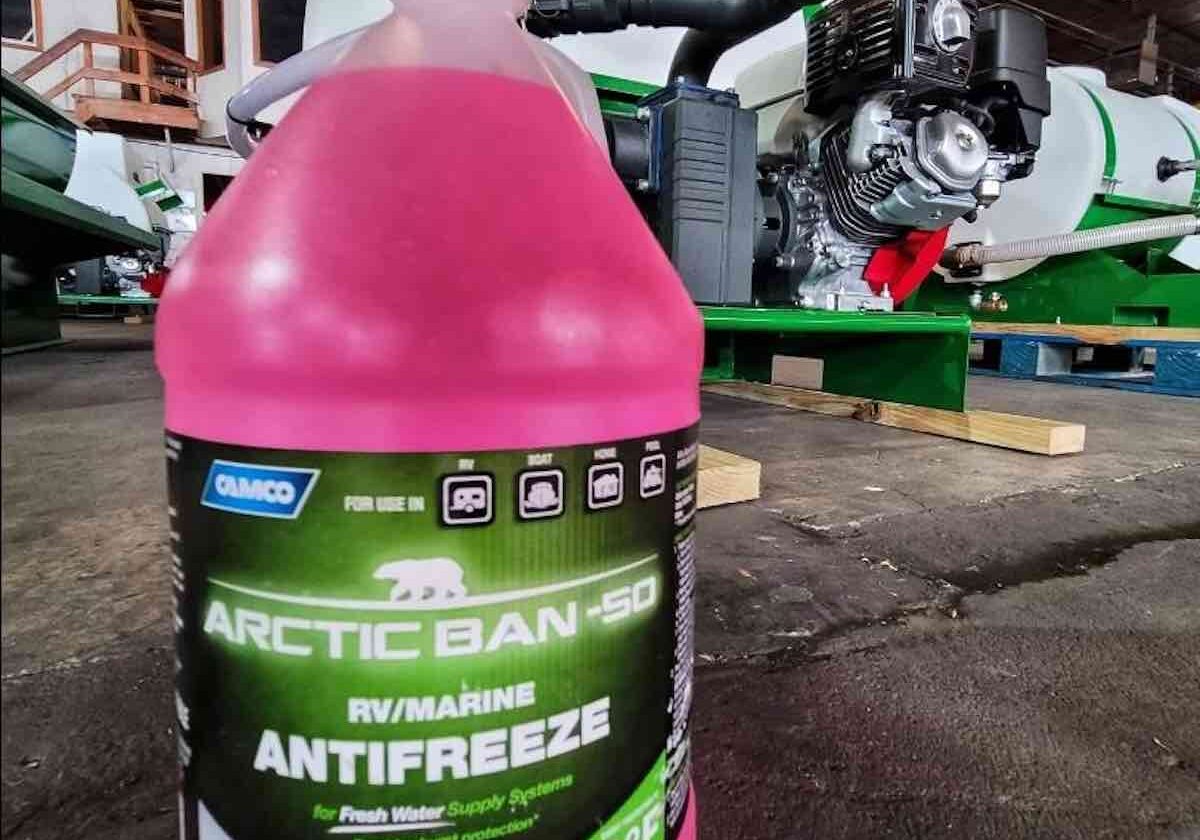Care & Maintenance of Jet Agitation Hydroseeders

Share this article!
Taking proper care of your jet agitation hydroseeder can make a critical difference for both the machine’s performance and reliability. For a hydroseeder that can go the distance with you season after season, making sure you complete the right hydroseeder maintenance and winterization can protect your investment and help keep everything running smoothly for as long as possible.
Whether you’re a landscaping professional, small business or home owner, taking care of common issues that can come up with jet agitation hydroseeders and learning how to winterize them effectively can help keep your equipment in peak condition year-round, so you can get the very best hydroseeding results for all kinds of lawn projects.
Caring For Jet Agitation Hydroseeders
Caring for any machinery is an important part of maintaining its useful life and efficiency. Because routine maintenance can extend the lifespan of any hydroseeder, it’s just as important for jet agitation hydroseeders. There are a few key steps to keep your hydroseeder running like new:
After Each Use
It’s critical to clean out the hydroseeder after each use. Fully rinsing and clearing any residual or remaining unused slurry from the tank helps prevent clogging when the machine is ready to use again. If slurry is left in the tank for a long period of time, the fertilizers and mulch can become rancid or moldy, which will mean you’ll need to spend extra time cleaning out the tank before the hydroseeder is ready to use again.
In order to properly clean out the tank, fill the tank at least half full with clean, fresh water. Once the water is added, start the engine — this process will dilute any remaining slurry, making it easier to drain. While the engine is running, flush all discharge lines in a designated area. Once you see only water (it will have a faint green tint) coming out of the nozzle tip, close all discharge valves and shut the engine off. Finally, open the tank drain valve to drain the remaining liquid. If possible, use a garden hose to rinse the tank walls and tank sump, ensuring all remaining slurry and debris is removed. Following this process is the best way to prevent clogs and to ensure the machine is ready for the next use.
Routine Jet Agitation Hydroseeder Maintenance
In addition to clearing out the tank after each use, doing some additional routine maintenance on your jet agitation hydroseeder can help keep your equipment in top form. It’s a great idea to create and stick to a maintenance schedule to make sure each component of the hydroseeder is cared for in a timely fashion.
Engine
To keep your hydroseeder’s engine running smoothly, make sure you’re checking the main components on a regular schedule, which should be at least once a year. This check should include features like the oil and oil filter, fuel and air filter, battery, and belts. When getting ready to store the hydroseeder, it’s a good idea to add a fuel stabilizer like Sta-Bil Fuel Stabilizer to the fuel tank per the manufacturers’ instructions, and run the engine for 15 minutes.
Pump
Inspect the pump for general wear and tear, this will help you see if there are any parts that need to be replaced in the pump casing or seal. Test the pump seal for leaks, and replace as needed. If stowing the hydroseeder for an extended period of time, once you’ve inspected the pump, empty the water and add antifreeze and spin the pump before stowing the hydroseeder. This will help prevent rust during the off season.
Tank
When doing your tank maintenance, pay attention to both the inside and the outside of the tank. For the exterior, inspect the tank and clean any areas that may have dried fertilizer or slurry residue on them. The tank interior also needs to be cleaned, emptied, and dried before being stored away for the winter. Additionally, check the tank’s bearings and seals to ensure there are no leaks — this is a great time to replace faulty or leaking seals.
Hose
Hoses need to be cleared and inspected regularly, and especially before storing the hydroseeder for any length of time. Clear and drain the hoses and flush any reels and piping along with the hoses. If your machine is equipped with a hose reel, and if possible, use compressed air, to blow the remaining content out of the hose (MAKE SURE DISCHARGE VALVE IS OPEN). Check the hose gaskets and seals for leaks and replace any as needed. Lastly, grease all fittings on the hose reel swivel and bearings, and the turret swivel if applicable.
Valves
Open and close all of the ball valves 3 or 4 times to clear any water from the area that surrounds the rotating ball. When complete, leave all ball valves open for storage. If the pump is equipped with a valve drain, open and close the valve to allow antifreeze to seep into the crevasses of the valve. (This process can be done for all valves, but the pump drain valve is the only valve that should remain close to retain antifreeze during winter storage.)
Common Issues and Solutions for Jet Agitation Hydroseeders
The most common problems that impact jet agitation hydroseeders are clogs, and these often result from skipping the cleaning process after seeding. Clogs can also occur when the slurry is not mixed properly, or when the wrong products are used in the slurry mix.
Clogs
Incomplete mixing, or improper cleaning can each cause clogs in jet agitated hydroseeders. These clogs can slow down the hydroseeding process and potentially damage the equipment. The best way to prevent hydroseeder clogs is to use the correct type of mulch for the hydroseeder (more on that below), blend the slurry for the advised period of time to ensure proper dispersal and uniformity before application, and thoroughly clean the unit after each use.
Using the Wrong Type of Mulch
Jet agitation hydroseeders are great at breaking up certain kinds of mulch – namely, paper (cellulose) mulch. Our 8K series can handle blends up to 70/30 (70% paper 30% wood). Because slurry is mixed with jets rather than mechanical paddles, other types of mulch like wood mulches and blended wood and paper mulches can cause problems in a jet agitated machine.
For best results, use the recommended mulch for your equipment, and read all the instructions and packaging on the mulch to be sure it’s suitable for use with a jet agitation hydroseeder.
How to Winterize a Hydroseeder
You can’t talk about proper hydroseeder maintenance and maintenance schedules without bringing up winterization. Whenever your machinery will be sitting idle for an extended period of time, it’s important to make sure you’ve taken the correct steps to prevent issues when it is time to hydroseed again.
Often, just taking a few extra minutes to go through the steps to winterize your hydroseeder can mean you hit the ground running quickly and easily at the start of the next season.
Step-by-Step Winterizing Instructions
Here’s a step-by-step guide to winterizing a hydroseeder. This ensures that all the equipment’s components are properly looked after before storing the hydroseeder.
1) Drain and rinse the tank
The tank is one of the most important places on the hydroseeder to properly winterize, so you want to take your time and make sure this step is done thoroughly. After draining and rinsing the tank, it should be clean and empty of any slurry debris or residue. It’s also best to get it as dry as possible before storage.
2) Flush the hoses
Hoses also need to be clear of debris and residue, and the best way to do this is to flush them with water until they run clear. Visually inspect the hoses for any kinks or cracking, and to make sure there are no signs of slurry left.
3) Prime the slurry pump
Drain the water from the pumps and apply some oil or grease to prevent rust issues.
4) Remove and store valves
Remove any and all valves that can be removed from the unit, and store them in a dry place with your hydroseeder so as not to lose track of them.
5) Engine and Drive Components
Visually inspect the engine and drive components to be sure nothing needs tuning or replacing – be sure to check the oil and air filters, fan belt, clutch, chains and belts, shaft couplers, and gear boxes. Disconnect the battery and store it in a climate-controlled area nearby. Additionally, for wheeled hydroseeders, check the tires and wheel bearings, as well as the hitch, hitch bolts and any safety chains to make sure they’re all in proper working order, and note any areas that may need to be replaced or repaired.
Winter Storage for Hydroseeders
In order to extend the useful life of your hydroseeder, it’s important to keep it protected from the elements during off-season storage. Find a dry place to store it, or cover it securely with a tarp to prevent water from contacting it.
Ideally, store the machine in a somewhat inverted or tilted position, so that any water remaining in the tank from cleaning can find its way out.
Conclusion
It’s true that an ounce of prevention is worth a pound of cure, and this applies to hydroseeders, too. By taking the time to make sure your equipment is prepped for any dormant period, you’ll have an easier time of it when the weather is ready for hydroseeding again. For more information on how to winterize a hydroseeder, set up a hydroseeder maintenance schedule, or routine maintenance, reach out to our pros for answers and more great tips.

